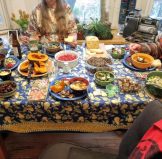
Agave seed stalk
The day before Thanksgiving in the Reshetnik-Brawer home was largely spent cleaning the house, but we also decided it was time to cut down the towering inflorescence of our Century Plant (Agave utahensis x parryi v. couesii). I held the 3”- thick stalk while Mikl cut through it with his folding hand-saw (a great tool!), then we laid it down on a ground-cloth to catch the copious seeds that fell out of the hundreds of pods. To me it felt as if we had just felled a large and noble animal or tree, and there were several quiet minutes of awe and reverence. Now that it was horizontal, we were able to get an accurate measurement of the bloom stalk’s height, 14.5 feet, and I counted 34 branches! We will be planting the hundreds (or thousands?) of seeds to produce new plants for you.
This particular naturally-occurring hybrid is quite cold-hardy and xeric, and will develop a very beautiful and impressive rosette of blue-gray foliage that will bloom (and subsequently die) after about 30 years. And your initial plant will produce lots of ‘pups’ (offshoots from the root system) over the years, and these can be harvested and transplanted to new locations. You may eventually be able to have Century Plants blooming every year or two or three, starting with your first plant!
 With wintry weather finally descending on the front range late Thursday afternoon, we were among the lucky ones that didn’t need to drive home on dark, snowy roads or brave crowded airports to spend the day with people we love. Mikl’s youngest brother, Preston, and his wife Jo, both vegetarians, came down from Fort Collins bearing Pres’s fabulous homemade breads, wild rice pilaf, broccoli salad and his very wicked chocolate mousse. Our contributions to the vegetarian feast were a kale and green lentil soup with fried polenta ‘croutons’, baked home-grown winter squash (my favorite, Uncle David’s Dakota Dessert Buttercup), fresh mushroom sauté, fresh cranberry/orange relish, and a big salad. Fort Collins is only an hour’s drive from home, but somehow, we hadn’t had a chance to get together with Pres and Jo since we all descended on the rest of the Brawner family in Iowa City a year ago. IMO, our lives shouldn’t be this busy.
With wintry weather finally descending on the front range late Thursday afternoon, we were among the lucky ones that didn’t need to drive home on dark, snowy roads or brave crowded airports to spend the day with people we love. Mikl’s youngest brother, Preston, and his wife Jo, both vegetarians, came down from Fort Collins bearing Pres’s fabulous homemade breads, wild rice pilaf, broccoli salad and his very wicked chocolate mousse. Our contributions to the vegetarian feast were a kale and green lentil soup with fried polenta ‘croutons’, baked home-grown winter squash (my favorite, Uncle David’s Dakota Dessert Buttercup), fresh mushroom sauté, fresh cranberry/orange relish, and a big salad. Fort Collins is only an hour’s drive from home, but somehow, we hadn’t had a chance to get together with Pres and Jo since we all descended on the rest of the Brawner family in Iowa City a year ago. IMO, our lives shouldn’t be this busy.

Buttercup, one of the sweetest squash with dry, golden flesh.
Getting back to the winter squash, here’s a link to good information about how long you should store the different types and varieties: https://territorialseed.com/blogs/news/winter-squash-harvest-curing-storage-charts. Some people report a lot more storage success if they use a light vinegar solution (one part vinegar to four parts water) to wipe the outside of all the cured squash. This removes mold spores and bacteria on the rind that can spoil them during storage. Another tip is that squash keep longer if you can slow the respiration rate. This can be done by lowering the temperature. Every 18 degree reduction in temperature increases the time for storing winter squash. Keeping winter squash in a temperature of 50 to 55 degrees F. (10-13 C.) is the optimum range for most types. Good ventilation is also necessary, as it helps prevent rot and maintain uniform temperatures and humidity in the storage area.
